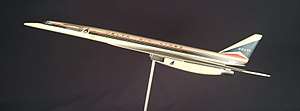North American NAC-60
The North American NAC-60 was the first American supersonic transport (SST) project. The development took place in the 1960s as part of a government-funded design competition to build an American SST[1] as the joint Anglo-French Concorde and the short-serviced Soviet Tupolev Tu-144 was underway. The design, however, was rejected in favor of the Lockheed and Boeing designs, allowing them to get further study.
| North American NAC-60 | |
|---|---|
 | |
| Side view of a North American NAC-60 | |
| Role | Supersonic transport |
| National origin | United States |
| Manufacturer | North American Aviation |
| Status | Canceled in 1967 |
Design
The North American NAC-60 had a set of canards at the nose, but this was essentially a scaled-up B-70 Valkyrie. These would provide extra stability or control, replacing the tail. As the NAC-60 was an SST, no horizontal stabilizer was needed, while the Concorde it was meant to compete with had a wing specially designed for both subsonic and supersonic flight, which, as a result, did not need a canard.
Specifications (North American NAC-60)
Data from FLIGHT international [1]
General characteristics
- Crew: up to 4 flight crew
- Capacity: 187 passengers / 35,000 lb (15,876 kg) payload
- Length: 195 ft (59 m)
- Wingspan: 121 ft (37 m)
- Height: 48 ft (15 m)
- Max takeoff weight: 480,000 lb (217,724 kg)
- Powerplant: 4 × afterburning turbojet engines
Performance
- Maximum speed: 1,520 kn (1,750 mph, 2,820 km/h)
- Maximum speed: Mach 2.65
- Range: 3,389 nmi (3,900 mi, 6,276 km)
References
- "THE UNITED STATES SST CONTENDERS". FLIGHT international. 1964-02-13. p. 235. Retrieved 2019-09-14.